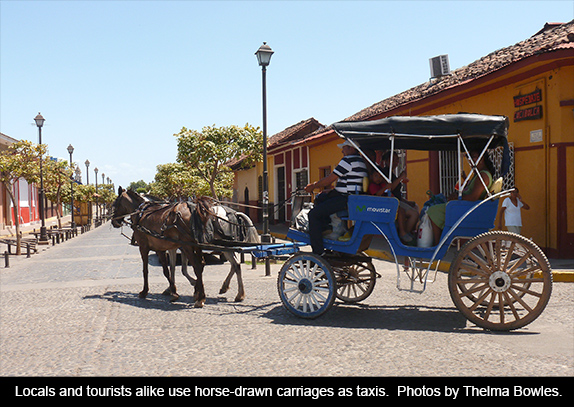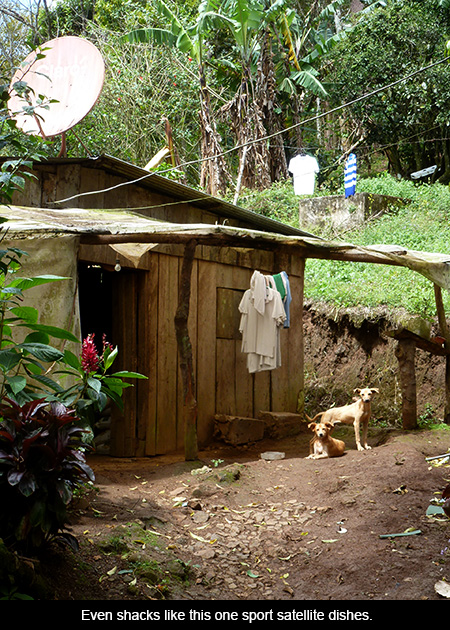
This is the second of four columns on a journey through Nicaragua.
On a volcanic island in vast Lake Nicaragua, a team of oxen slowly trudges along a dirt road pulling a cart laden with large logs. Driving the cart is a young man with only part of his mind on his task. The rest of his attention is devoted to his conversation on a cell phone.
Hundreds of kilometers and a week later, a heavily set, elderly woman makes her way slowly and painfully through the cloud forest and up a dirt track in Parque Arenal high in the mountains in northern Nicaragua. She, too, is talking on a cell phone.
In the second largest hotel in the small city of Somoto, gateway to what is sometimes called the Grand Canyon of Central America, I am awakened before dawn by a rhythmic pounding. When I go into the dining area for breakfast, I discover what it was: a woman making masa paste and forming it into corn tortillas, which she fries over an open wood fire in the middle of the dining room.
Nicaraguans do not look like the second-poorest people in the western hemisphere. They are for the most part neatly dressed and adequately fed. They are healthy with a few exceptions: crippled elderly veterans of American-backed wars in the 1970s and 1980s, sugar cane workers for the country’s first and only billionaire, and Dole’s banana workers, both of these groups reportedly poisoned by chemicals.
Nicaraguans’ homes have sewer systems, electricity and potable water. Everywhere satellite dishes adorn the roofs of tin and tarpaper shacks. WiFi, computer stores and cell phones are ubiquitous. In three weeks of travel, we saw fewer homeless people and fewer beggars than we would normally encounter in an hour in Albuquerque.
Major roads are well paved, mostly with paving stones laid down by hand. Buses (usually resurrected old school buses) go everywhere and do so frequently and for the most part on time. Expats sneeringly dismiss them as “chicken buses,” although I never saw a live chicken on one. I did, however, see a live pig strapped to a platform at the rear of such a bus.
Every town seems to have a campaign to keep rubbish in trash containers and off the streets, and it seems to be largely successful.

In Granada, horse-drawn carriages await tourists at the Parque Central. In Masaya, Nicaraguans are the main customers of the carriages. Everywhere in Nicaragua, horses pull heavily laden carts along urban highways and rural tracks, teaching bus drivers a valuable lesson in patience. Houses in the cities are tiny and hot, and in the evening, streets are lined with men and women sitting in doorways enjoying the coolness and watching their kids play in the middle of the roads with homemade balls.
In every town and city, on every weekday, long lines form early in the morning outside banks and Western Union offices. Nicaraguans are there to pick up remittance money from their 1 million relatives (one-seventh of the total population) working in the United States, Costa Rica and elsewhere. This money, plus subsidized gas from Venezuela and health workers from Cuba, keeps the wheels turning in a country in which there are almost no jobs, no industry and, with the exception of some gold and a few agricultural products (coffee, bananas, beef, tobacco, and sugarcane), no exports. Within Nicaragua, however, the coffee is almost invariably excellent, and the domestic Flor de Caña may be the world’s best rum. Nicaraguan cigars, too, receive high praise.
Like many other countries, the easy generalities about Nicaragua are almost invariably wrong. The one great truth is this: Nicaragua has had an unusually brutal history whose scars are everywhere, on the land and in the cities—pirate raids, invasions, volcanic eruptions, earthquakes, civil wars, dictatorships. But somehow (just how is beyond me) the people have emerged from this history impoverished but intact, proud to an astounding degree of what they are but with little hubris, for what they lack is all too obvious.
A good place to begin to understand these contradictions is the long and troubled relationship between Nicaragua and the United States. As early as 1845, the U.S. was telling Nicaragua what to do and how to do it. In the 1850s a maverick U.S. “filibusterer,” a pirate with official US. support, conquered Nicaragua and made himself president, before burning down its most notable city, Granada.
The U.S. Marines more or less governed the country from 1909 to 1933, when Franklin Roosevelt inaugurated his “Good Neighbor policy.” In 1914, just as the Panama Canal was opening for business, the U.S. made Nicaragua sign a treaty granting the U.S. the exclusive right to build an inter-ocean canal, although it had no intention of building one in Nicaragua; now it’s the Chinese with exclusive canal rights.
In 1927, the U.S. used Nicaragua to inaugurate what became the international practice of using bombers to attack cities.
With strong U.S. financial and military support, the Somoza family seized power and ruled, and practically owned, the country from 1936 to 1979. Its downfall began with an earthquake that destroyed most of the capital in 1972 and left 150,000 people homeless. When the Somozas failed to cope with the tragedy and in fact stole most of the $75 million in foreign aid donated by the U.S., the Sandinista revolt caught fire.
The U.S. and the Somozas were defeated by the leftwing Sandinistas. The group was named for Augusto César Sandino, who led guerrilla warfare against the U.S. Marines from 1927 to 1933 and was killed by the Somoza government in 1934.
In the 1980s, the CIA created a disparate rebel group of ex-soldiers, Indians and landowners dubbed the Contras (meaning “against,” the only applicable name since they could not agree on what they were for). When the Contras lost, the U.S. imposed a trade embargo that bankrupted what was left of the country.
Since then, the American government position has been to give Nicaragua a bit of humanitarian aid, enlist it in a tariff-cutting treaty that allows the U.S. preferential access to Nicaraguan markets, and more or less ignore the country otherwise. Benign neglect would not be an inappropriate phrase.

The result is that today the U.S. is not a large presence in the country despite all those lines outside the banks, a contingent of 164 Peace Corps volunteers, a huge embassy estate in an isolated suburb of Managua, and a clutch of retired businessmen and lawyers, mostly in the conservative and refurbished old colonial capital of Granada. Most of the small foreign aid projects are undertaken by nongovernmental organizations. Many of the 1 million tourists a year are from Germany and Canada. Even Australians, Dutch and Swedes are more in evidence than Americans.
While the relations between the self-consciously socialist Nicaraguan government and the U.S. government remain rocky, on a human and personal level, they are not. My wife and I never—not once—encountered hostility because of our nationality, a statement I could make about few of the other countries we have visited.
I found this combination of traumas and virtues fascinating and entrancing. Though explaining it all is a tall order, relishing it is not.



Responses to “Exploring Nicaragua, Part Two: Emerging from a brutal past”